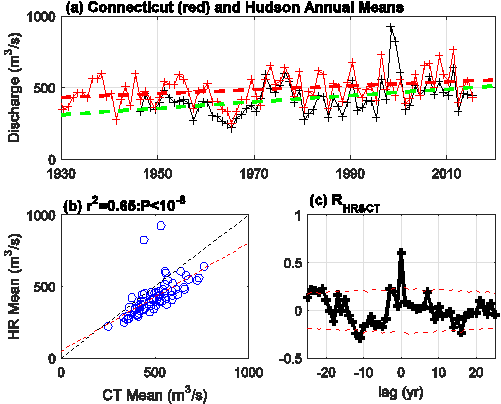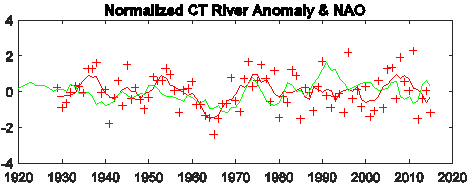

| Home Precipitation River Discharge Sea Level Air Temperature Water Temperature Cloudiness Wind Download Data |
Introduction
|
||||||||||
| This figure shows the average seasonal cycle in the discharge measured at the U. S. Geological Survey’s gaging station at Thompsonville, CT (from O’Donnell et al., 2014). On average, the peak flow occurs in April. However, the variability in the time of the peak flow is substantial and this leads to the large standard deviations and a broad peak in the monthly average discharge that spans March-May. The average annual discharge is approximately 500 m3/s (shown by the horizontal line). Clearly, during nine months of the year the monthly mean flow is below the annual average. |  |
There is substantial inter-annual variation in the discharge
of the river that is driven by regional scale meteorological variability, and
Whitney (2010) has shown that the Connecticut and several other rivers of the
eastern United States correlate with the North Atlantic Oscillation (NAO) index
(Hurrell, 1995). Using the same record, O'Donnell et al. (2010) showed that the
day of the year by which 50% of the annual discharge has passed the gauge, the
"center of volume flow," has become earlier at a rate of 9 ± 2
days/century. That the fresh water stored in the winter ice and snow pack
arrives at the ocean through the Connecticut River earlier than in the past is
consistent with the analysis of unregulated New England rivers and streams
reported by Hodgkins et al. (2003) and is, therefore, likely to be a
consequence of regional meteorological fluctuations rather than changes in
watershed management.
Changes in the magnitude and timing of the freshet and the
mean annual discharge will have significant implications for patterns of
circulation and sedimentation in the Sound, and may also have implications for
some aquatic and marsh species along the shore. Flooded fields and marshes during the freshet provide
critical feeding habitat areas for migratory waterfowl and fish. The freshet also
carries a large fraction of the annual sediment load to the Sound and the
timing and magnitude may have long term impacts.
| We examined the trends in the discharge in the
Connecticut and Hudson Rivers. These both have a major influence on the
salinity in LIS and consequently, the patterns of circulation and mixing. The
effects are quite different since the location of the sources and the mechanism
that control the distributions are quite different. Our analysis has
demonstrated that the character of river discharge patterns is very similar in
the Connecticut and Hudson and that they have exhibited large decadal-period
oscillatiWe showed that the
annual discharge in both rivers was increasing. on and secular trends during the last century. The decadal scale fluctuation in the two rivers were found to be significantly correlated at zero lag and negatively correlated at approximately 10 years, indicating that the forcing of the long period fluctuations affected the watersheds of the two rivers in a similar manner. However, despite the similarity in the character of the variations in the records, the correlation with the NAO index showed was not found to be significant. This seems likely to be a consequence of the highly variable lags in the relationship between precipitation and streamflow in very large basins. |
 |
 |
|
| We also conformed an earlier finding that the spring freshet was occurring earlier in the spring (the WSCV was decreasing) and was advancing at a rate of 8 days/century. The Hudson was shown to be undergoing a similar trend though at a slower rate. |  |
| The most significant and novel result of the analysis is that the streamflow in the spring was stable and that the discharge in the low-flow months (June-December) was increasing. The rate of increase has led to almost a doubling of the amount of water reaching New York Harbor and LIS in these months. To more clearly illustrate the magnitude of the changes that have occurred we divided the year in to three phases based on the average seasonal cycle. The “low” phase extends from June to October when both the 5-day and monthly means are below the annual average. The “average” flow interval occurs in November to February and the “high” phase is March to May, when the spring freshet occurs. Note that these intervals are not of equal length. We then computed the total volume passing the gages in the three intervals each year and calculated the fraction of the annual freshwater volume occurring in each. |
 |
Bradbury, J.A., S.L. Dingman and B.D. Keim. (2002).
New England Drought and Relations with Large-Scale Atmospheric Circulation
Patterns. Amer. Water. Res. Assc. V 38, No. 5, 1287-1299
Hodgkins G.A.,
R.W. Dudley and T.G. Huntington (2003). Changes in the timing of high river
flows in New England over the 20th Century. J. Hydrology V278, 244–252
Gay, P.S., J.
O’Donnell and C.A. Edwards (2004). Exchange Between Long Island Sound and
Adjacent Waters J. Geophys. Res. 109, C06017, doi: 10. 1029/2004JC002319.
Hurrell, J.W.
(1995). Decadal Trends in the North Atlantic Oscillation Regional Temperatures
and Precipitation. Science 269: 676-679.
Hurrell, J.W.
and C. Deser (2009). North Atlantic climate variability: The role of the North
Atlantic Oscillation. J. Mar. Syst., 78, No. 1, 28-41 - See more at:
https://climatedataguide. ucar. edu/climate-data/hurrell-north-atlantic-oscillation-nao-index-pc-based#sthash.
77h8RnZx. dpuf
O'Donnell J,
J. Morrison and J. Mullaney (2010). The expansion of the Long Island Sound
Integrated Coastal Observing System (LISICOS) to the Connecticut River in
support of understanding the consequences of climate change. Final Report to
the CTDEP, LIS License Plate Fund, 20pp.
O'Donnell, J.,
R.E. Wilson, K. Lwiza, M. Whitney, W.F. Bohlen, D. Codiga, T. Fake, D. Fribance,
M. Bowman, and J. Varekamp (2014). The Physical Oceanography of Long Island
Sound. In Long Island Sound: Prospects for the Urban Sea. Latimer, J. S.,
Tedesco, M., Swanson, R. L., Yarish, C., Stacey, P., Garza, C. (Eds.), ISBN-13:
978-1461461258
Whitney, M.M.
(2010). A study on river discharge and salinity variability in the Middle
Atlantic Bight and Long Island Sound. Cont. Shelf Res 30:305-318
Willmott, C.J.,
S.G. Ackleson, R.E. Davis, J.J. Feddema, K.M. Klink, D.R. Legates, J. O'Donnell,
and C.M. Rowe (1985). Statistics for the Evaluation and Comparison of Models. J.
Geophys. Res. 90: 8995-9005.